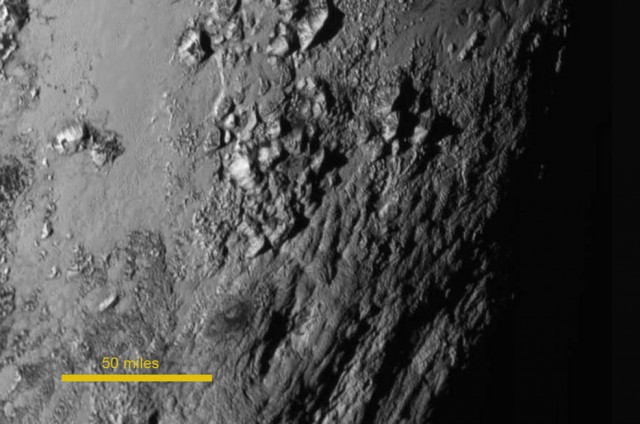16 July 2015
Pluto has mountains, so does it have landslides too?
Posted by Dave Petley
Landslides on Pluto?
Overnight a series of stunning images of the surface of Pluto have been sent back to Earth by the NASA New Horizons spacecraft. These images are so good that they have even made the first story on the BBC News website – quite remarkable given the importance of the Greek debt crisis. The discovery that Pluto is geologically active seems astonishing, not least because a mechanism to drive active geological processes is not apparent.
The presence of mountains on the surface of the planet, and the absence of impact craters, suggests some form of active uplift process. On Planet Earth, active uplift is always accompanied by some level of active erosion, and in the presence of water this denudation is usually accomplished primarily by landslides. In extremely arid environments, erosion may be driven by seismically-induced landslides, as we explored in our recent paper on the 2010 Mexico earthquake (Barlow et al 2014). So a fascinating question is whether the creation of young mountains on Pluto also means that landslides (in this case ice avalanches presumably) are present too.
The image below has been generated by NASA, showing mountains rising 3500 m above the base surface near to Pluto’s equator. These mountains are thought to be formed from ice and are less than 100 million years old. Note the scale of the image, 50 miles is about 80 km:

Pluto from New Horizons. Image credit: NASA-JHUAPL-SwRI
.
Although I am no planetary scientist, on first inspection there are features on the surface that are reminiscent of active slope processes. This is an enlargement of the image in which I have annotated some key features:-

Annotated image of Pluto from the New Horizons mission. Image credit: NASA-JHUAPL-SwRI
.
I am speculating here as to the nature of the features, but on many of the slopes there are streaks that look like landslide tracks, and there also appears to be debris at the slope toes in many places. In the mountain on the “north” side of the image there is a feature that could well be a landslide track with a displaced mass at the toe – this has many of the features of a terrestrial landslide, although of course this would be a very large body. Finally, and pushing the boundaries of speculation to an extreme, in the “southeast” portion of the image there is a mountain with a huge arcuate face and what appears to be debris at the toe. Could this be a giant mountain collapse landslide? If so it will be of enormous volume.
I am sure that the NASA scientists will be looking at these images in detail in the months ahead, and will be able to come to a much better conclusion about whether Pluto has landslides. But I will be surprised if it does not.
Reference
Barlow, J., Barisin, I., Rosser, N., Petley, D., Densmore, A. and Wright, T. 2014. Seismically-induced mass movements and volumetric fluxes resulting from the 2010 Mw = 7.2 earthquake in the Sierra Cucapah, Mexico, Geomorphology, Available online 24 November 2014, http://dx.doi.org/10.1016/j.geomorph.2014.11.012.


 Dave Petley is the Vice-Chancellor of the University of Hull in the United Kingdom. His blog provides commentary and analysis of landslide events occurring worldwide, including the landslides themselves, latest research, and conferences and meetings.
Dave Petley is the Vice-Chancellor of the University of Hull in the United Kingdom. His blog provides commentary and analysis of landslide events occurring worldwide, including the landslides themselves, latest research, and conferences and meetings.
Is the lineament running “NW-SE” in the photo a join between photos or geological? (Fault trace, fracture….)